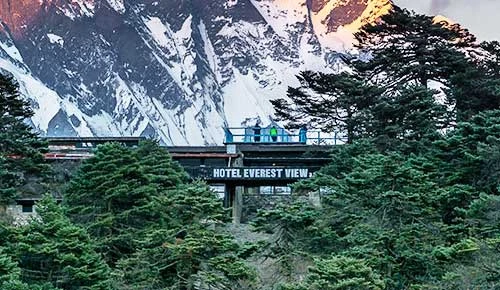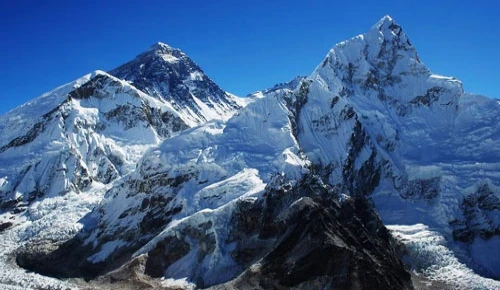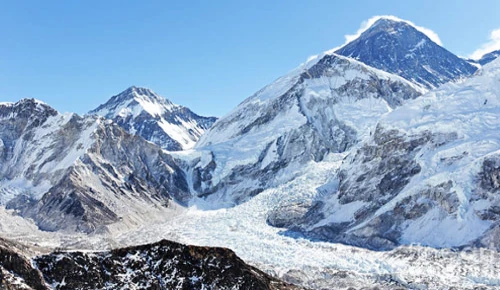Things to Know About Everest Helicopter Return Trek
The fun of the Everest Base Camp Trek lies in its promise of an extraordinary adventure through the mesmerising landscapes of the Himalayas, culminating at the foot of the world's tallest mountain. While the traditional trek offers a rewarding challenge, the option of a helicopter return adds a touch of luxury and convenience to this unforgettable experience.
The helicopter, accommodating up to five individuals, introduces a swift and scenic alternative for those with time constraints or a desire for added comfort. It not only reduces the trekking duration but also offers an exclusive aerial perspective of the majestic Himalayan terrain. It's worth noting that the helicopter comes with weight restrictions, adding a practical consideration for participants.
This unique blend of adventure and opulence makes the Everest Base Camp trek with helicopter return an enticing proposition for both seasoned trekkers and those looking to savour the Himalayan wonders in a distinctive way.
Table of Contents
Understand the Itinerary and Duration
This trek typically ranges from 9 to 12 days, depending on your chosen itinerary. Most itineraries include a Kathmandu to Lukla regular flight and a helicopter flight back. The first few days involve acclimatisation walks through the charming Sherpa villages of Phakding, Namche Bazaar, and Tengboche. As you ascend higher, the scenery becomes increasingly breathtaking, with panoramic views of snow-capped peaks and verdant valleys. Finally, you reach the iconic Base Camp, nestled amidst the grandeur of the Himalayas. The helicopter return from Gorakshep or Lukla provides a swift and scenic descent back to Kathmandu.

Best Season or Time
Season | Pros | Cons |
Spring (March-May) | Pleasant weather, clear skies, abundant wildflowers, gradual acclimatization, lower crowds | Peak season, muddy trails, and limited accommodation |
Autumn (September-November) | Stable weather, clear skies, fewer crowds, and easier acclimatiation | Some trails are closed, limited accommodation |
Winter (December-February) | Fewest crowds, affordable prices, unique experience, lower altitude sickness risk | Coldest temperatures, harsh weather, inaccessible trails, limited accommodation |
Summer (June-August) | Lush greenery, blooming rhododendrons, longer daylight hours | Monsoon season, cloudy skies, higher altitude sickness risk |
According to data, winter (December–February) has the fewest flight cancellations and delays due to bad weather for helicopters. This is because the winter months typically have more stable weather conditions, with less precipitation and fewer storms. It's less likely your flight will get cancelled or delayed during this season.
Preparation and Training
While the trek doesn't require expert mountaineering skills, a moderate level of fitness is essential. Regular exercise, particularly cardio and strength training, will enhance your endurance and prepare your body for the strenuous climbs and ascents. Practice hiking on moderate inclines to strengthen your legs and improve your cardiovascular health.
Clothing and Gear
Pack light and smart, ensuring you have the necessary gear for the trek. Some of the essential items include:
- Sturdy, waterproof hiking boots that provide ankle support and traction on uneven terrain.
- Layers that can be easily added or removed as the weather changes. A warm down jacket is crucial for higher altitudes.
- Waterproof jacket and pants are essential for unpredictable mountain weather.
- Carry a comfortable daypack to store essentials like water, snacks, and rain gear.
- Trekking poles provide stability and reduce strain on your knees and joints.
- Diamox or other altitude sickness medication is recommended for those sensitive to high altitudes.
- Pack basic first-aid supplies to treat minor injuries or ailments.
Investing in high-quality gear is crucial. Research shows that proper clothing and equipment significantly contribute to trekker comfort and safety.
Helicopter Ride Safety
Helicopter flights in the Himalayas are generally safe, but it's important to be aware of potential risks and take necessary precautions.
- Go for an experienced and reputable helicopter company with a proven safety record.
- Helicopter flights are subject to weather conditions, and cancellations may occur due to poor visibility or strong winds. Following the guidelines of the trekking company or pilot is a must.
- Adhere to the weight restrictions imposed by the helicopter company, as overloading can affect safety.
Trekking Guide
All solo trekkers to Everest Base Camp must now be in the company of a certified guide as of April 1, 2023, according to a new law that Nepal's government has put into place. This decision was made to enhance the safety and well-being of travellers, particularly solo travellers, who may face additional challenges and risks while trekking in remote areas.
The data show that having a guide is essential for several reasons:
- 102 deaths were reported (2016–2021) among Everest trekkers.
- 35% of fatalities involved solo trekkers.
- Solo trekkers are twice as likely to experience severe altitude sickness (Journal of Travel Medicine).
- 23% of solo trekkers (2022 survey) felt uncomfortable due to cultural misunderstandings.
- 42% of solo trekkers faced language barriers in remote Nepal (Nepal Tourism Board, 2021).
- 70% of trekker rescues in Everest involved solo trekkers (Himalayan Rescue Association, 2023).
- Guides are essential for solo trekkers, serving as translators and ensuring effective communication. They monitor conditions, advise on acclimatization, and enhance safety by identifying hazards. In emergencies, guides offer immediate assistance, administer first aid, and coordinate medical evacuations, providing crucial support throughout the solo trekking experience
So, a guide will make sure to add sweetness to your trek.
Permits and Documentation
- Obtain a trekking permit from the Nepal Tourism Board (NTB) or a registered trekking agency.
- Acquire a Trekkers Information Management System (TIMS) card for tracking your whereabouts during the trek.
- Comprehensive travel and medical insurance are essential for any trekking adventure. Ensure your policy covers high-altitude activities and potential medical evacuations.
- The Sagarmatha National Park entry permit is compulsory. It costs around USD 30.
If you book through us, we will obtain the documents for your convenience.
Altitude Considerations
- Altitude sickness is a common concern during the EBC Heli Return Trek. Acclimatization days are strategically included in the itinerary to allow your body to adjust to the decreasing oxygen levels at higher elevations. Listen to your body, stay hydrated, and communicate any symptoms of altitude sickness to your guide.
- Proper hydration is crucial at high altitudes. Drink plenty of water to help prevent altitude-related issues. Avoid excessive caffeine and alcohol consumption, as they can contribute to dehydration.
- Consider carrying altitude sickness medication like Diamox and consult with your healthcare provider before the trek. Familiarise yourself with the symptoms of altitude sickness, which can include headaches, nausea, and dizziness. Booking through travel agencies takes care of these medicines.
Symptoms of Altitude sickness
Altitude sickness manifests in various ways, with common symptoms including headaches, nausea, dizziness, fatigue, loss of appetite, difficulty sleeping, and shortness of breath. In more severe cases, altitude sickness can escalate to high-altitude pulmonary edema (HAPE), characterized by severe shortness of breath, coughing up pink or bloody phlegm, and a bluish tint to the skin and nails. Immediate descent to a lower altitude is crucial if any symptoms arise. Seeking prompt medical attention is essential, particularly if symptoms persist or worsen over time. These precautionary measures are vital for ensuring the well-being of individuals experiencing altitude-related challenges.Your guide will be a key help in dealing with these symptoms.
Here are some tips for preventing altitude sickness:
- Give your body time to adjust to the lower oxygen levels. It is recommended to ascend no more than 1,000 feet (300 meters) per day.
- Drink plenty of fluids, even if you don't feel thirsty.We say to drink about 15.5 cups (3.7 liters) per day for men and 11.5 cups (2.7 liters) for women.
- Eat foods that are high in carbohydrates and calories, such as dal bhat (a Nepali food) and potatoes.
- These substances can dehydrate you and worsen your symptoms.
- Your body needs time to recover from the stress of altitude.
- There are medications that can help prevent altitude sickness. Talk to your doctor about whether these are right for you.
Helipad Etiquette
Helipad etiquette is essential for ensuring the safety and efficiency of helicopter operations. When approaching a helipad, follow the instructions of ground crew and remain in designated areas. Secure all loose belongings, as strong winds can pose a safety hazard. During boarding and disembarking, move swiftly and carefully, ensuring your seatbelt is fastened when airborne. Maintain a respectful distance from the helicopter and avoid distracting activities. Treat fellow passengers and crew with courtesy and professionalism. By adhering to helipad etiquette, you can contribute to a safe and enjoyable helicopter experience for everyone.
Preparing for Your Helicopter Ride: Tips for a Thrilling Experience
Your helicopter ride back promises breathtaking views and an unforgettable experience. To maximize your enjoyment and ensure a safe and smooth journey, here are some specific tips to help you prepare:
Before the flight:
- Choose loose-fitting, weather-appropriate clothing. Wear layers for comfort, as temperatures can vary significantly during the flight. Sturdy shoes are crucial for uneven terrain on the helipad.
- Bring a small backpack with essentials like sunglasses, sunscreen, a hat, lip balm, and a camera. Consider bringing motion sickness medication if you are prone to nausea.
- Drink plenty of water before and during the flight to stay hydrated at high altitudes.
- Avoid bringing valuables like expensive jewelry or large amounts of cash.
- Carefully listen to the pre-flight briefing and instructions from the pilot and ground crew regarding safety procedures and helipad etiquette.
- Acclimatization is crucial. If your itinerary allows, spend a few days in Kathmandu or nearby areas to adjust to the higher altitude.
Safety Precautions:
- Always keep your seatbelt fastened throughout the flight, even when the helicopter is hovering.
- Refrain from using electronic devices that can interfere with flight operations.
- Don't attempt to get up or move around the helicopter while it's in flight.
- Keep your hands and belongings inside the helicopter to avoid any accidental loss or injuries.
- In case of an emergency, listen carefully to the pilot's instructions and remain calm. Follow all emergency procedures promptly and efficiently.
Making the Most of the Experience:
- Share your excitement and awe with your fellow passengers. Discussing the experience and exchanging perspectives can enhance the journey.
- Take photos and videos to capture the breathtaking views and preserve your memories. Consider using a wide-angle lens to capture the vastness of the landscape.
- Respect the environment and avoid littering or disturbing wildlife during your landing at EBC.
- Take some time after the flight to reflect on the unique experience and the awe-inspiring beauty of the Himalayas.
Trekking with NTA
Here at Nepal Trek Adventure, we make sure that your dream of adventure is turned into a reality that exceeds all your expectations. With our dedicated and highly skilled team members, we ensure to give you memorable, comfortable, and, most importantly, safe memories of your adventures with us. Here are some of the reasons why you should book your trip with us.
- We have an easy, accessible online booking system
- We operate by keeping your safety and comfort our top priorities. We ensure that no compromises will be made when it comes to our safety and comfort.
- We have a very transparent pricing policy so you will know exactly what you’re paying for.
- We commit to sustainable tourism by supporting local communities and helping to reduce our ecological footprint.
- We tailor your package according to your preferences and needs by customizing the package.
- Our guides and porters are locals who have in-depth knowledge regarding the Everest region and are highly trained with years of experience.
So, if a comfortable and safe adventure is what you are looking for, then book your Everest Base Camp Helicopter Return Trek with us.
Conclusion
Whether revelling in the stunning scenery or ensuring safety through proper preparation, the trek promises an unforgettable experience. From acclimatisation walks through Sherpa villages to the swift descent via helicopter, each aspect contributes to the lure of this iconic trek. Remembering to prioritise safety, cultural sensitivity, and responsible trekking practises, along with partnering with reputable trekking companies, ensures a harmonious and enriching exploration of the Everest region. With the added requirement of a guide for solo trekkers, the emphasis on safety underscores the commitment to a secure and enjoyable trekking experience.








